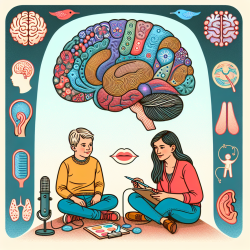Understanding the Default Mode Network: A Key to Enhanced Therapy
In the realm of speech-language pathology, understanding the brain's intricate networks can significantly enhance therapeutic outcomes for children. A recent study titled "Dark control: The default mode network as a reinforcement learning agent" by Dohmatob et al. (2020) sheds light on the Default Mode Network (DMN) and its potential role in optimizing behavior through reinforcement learning. This groundbreaking research provides insights that can be leveraged to improve therapy practices, particularly in online therapy services like those offered by TinyEYE.
The Role of the Default Mode Network
The DMN is a network of interacting brain regions known to be active when the mind is at rest and not focused on the external environment. It is associated with functions such as self-referential thought, envisioning the future, and autobiographical memory. The study by Dohmatob et al. proposes that the DMN functions as a reinforcement learning agent, continuously evaluating and predicting the environment to guide behavior.
Implications for Speech-Language Pathology
For practitioners in speech-language pathology, understanding the DMN's role in behavior optimization offers several practical applications:
- Enhanced Predictive Strategies: By recognizing the DMN's predictive coding capabilities, therapists can develop strategies that anticipate a child's responses and tailor interventions accordingly.
- Improved Engagement: Leveraging the DMN's involvement in self-referential thought can help create more engaging and personalized therapy sessions, fostering better outcomes.
- Adaptive Learning: The DMN's reinforcement learning processes can inform adaptive learning techniques, allowing therapists to adjust interventions based on real-time feedback from the child.
Encouraging Further Research
While the study provides a robust model for understanding the DMN, it also opens avenues for further research. Practitioners are encouraged to explore how these findings can be integrated into their practice and to contribute to ongoing research efforts. Collaboration with neuroscientists can help refine therapeutic approaches and develop new methodologies that align with the latest scientific insights.
Conclusion
The study by Dohmatob et al. offers a new perspective on the DMN's role in behavior optimization, providing valuable insights for speech-language pathologists. By integrating these findings into practice, therapists can enhance their interventions, ultimately leading to better outcomes for children. To delve deeper into the research, you can access the full paper here: Dark control: The default mode network as a reinforcement learning agent.










